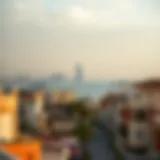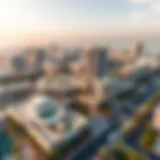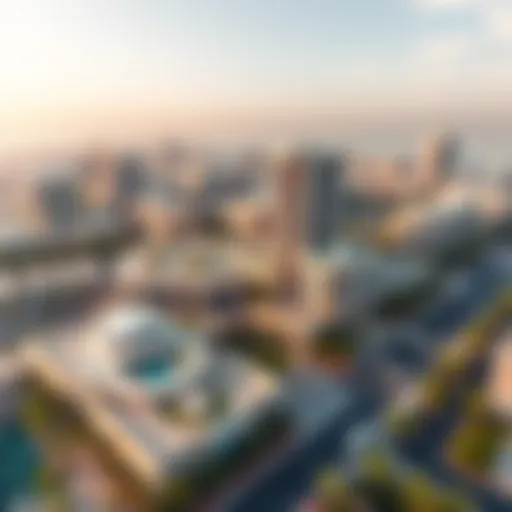Exploring the Souks of the UAE: A Detailed Insight
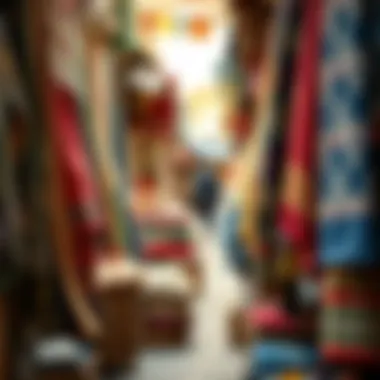
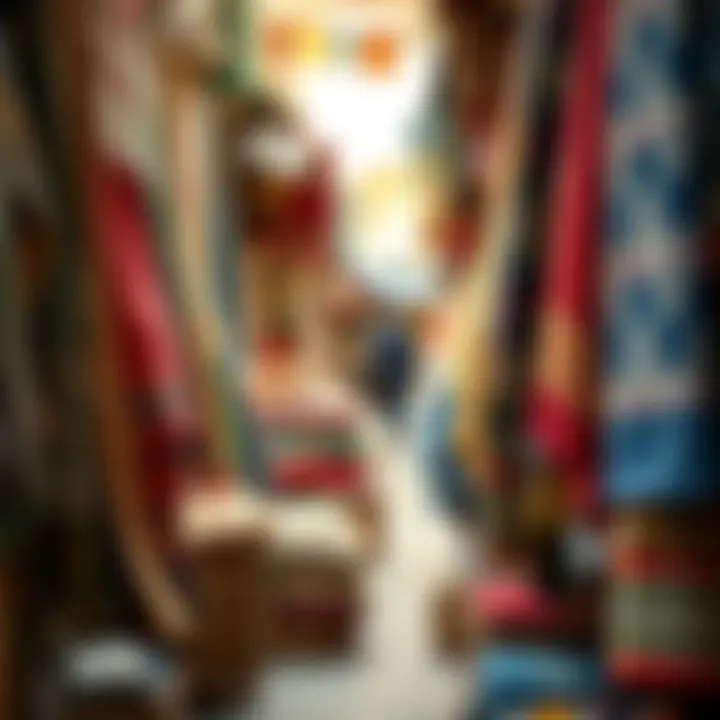
Intro
In the heart of the United Arab Emirates lies a timeless tapestry woven from rich history, vibrant culture, and astute commerce—its souks. These marketplaces are more than just shopping destinations; they serve as cultural crossroads, where tradition meets a rapidly shifting modernity. As one wanders through the winding alleyways, the scents of spices mingle with the sounds of traders extolling their wares, creating an atmosphere teeming with life. The souks are where stories abound, from the simple artisans crafting silver jewelry to the shopkeepers selling luxurious textiles that reflect the region's heritage.
The significance of the souks extends beyond mere commerce; they encapsulate the very essence of the UAE's identity. They give insight into local customs, traditions, and economic shifts. Emerging as economic hubs, these marketplaces have adapted to global trends while retaining their unique character. In this exploration, we will traverse various aspects of the souks, focusing on their historical context, contemporary relevance, and the rich interactions that these communal spaces foster.
As we dive into this detailed examination, we will address the market trends and insights that shape these bustling environments, uncover investment opportunities within the neighborhoods surrounding the souks, and explore the types of properties that investors may consider. Through a combination of cultural reflections and economic analysis, we aim to paint a vivid picture that showcases how these marketplaces contribute profoundly to the identity of the UAE.
Prelude to the Souks
Souks are not just markets; they are the lifeblood of cultural exchange and economic vitality in the United Arab Emirates. In this article, we embark on a journey to understand these bustling bazaars that have stood the test of time and continue to thrive in a rapidly modernizing world.
Before diving deep into the specifics, it's crucial to recognize the role souks play in the fabric of UAE society. They serve as both commercial hubs and community meeting points, where business happens alongside the warmth of human interactions. Here, one finds not only goods being traded, but also stories, traditions, and vibrant colors that form the essence of local life.
Defining Souks
The term "souks" comes from an Arabic root word that signifies market or marketplace. Unlike Western malls that focus on large retail chains, souks are typically characterized by their more personalized approach, offering a medley of goods from spices and textiles to gold and electronics. Visitors frequently encounter a dazzling array of items, laid out in stalls that evoke the history of trade in the region.
In practical terms, a souk can be small or sprawling, with its layout often resembling a maze. Vendors might range from large merchants boasting extensive inventories to small family-run stalls. This layered structure allows for a rich diversity of offerings, catering to every taste and budget.
Historical Context
To truly appreciate souks is to understand their historical backdrop. Dating back centuries, they were the hub of trade routes, linking Africa, Asia, and Europe. With the discovery of oil in the 20th century, the dynamics began to shift, but the importance of these markets remained intact. For many, visiting a souk is akin to stepping back in time, where the echoes of merchants hawking their wares still resonate.
Interestingly, each souk carries its own unique narrative, shaped by the local culture, economics, and even politics. Many traders convey tales of their ancestors who stood in the very same stalls, reinforcing a sense of continuity amidst change. Modern advancements haven't overshadowed this rich heritage; instead, they have adapted to complement it while keeping the essence alive.
In summary, souks are more than mere shops; they represent a treasure trove of cultural exchanges, vibrant histories, and economic vitality. By understanding what defines a souk and its historical context, investors and other interested parties can gain valuable insights into not just consumer behavior but also the very identity of a community.
"A souk is where centuries of tradition dance with the pulse of modern commerce."
So, as we dig further into this exploration, we shall unveil the uniqueness and economic significance of major souks while also considering the dynamics that govern them.
Major Souks in the UAE
The souks of the UAE stand as a testament to the region’s unique cultural and commercial history, cleverly intertwining tradition and modern needs. These marketplaces are not just places to buy and sell; they're vibrant hubs where the past meets the present, influencing both local customs and the economy. The significance of these souks can't be overstated. Each souk boasts its own identity, attracting visitors and locals alike.
Understanding the role of these major souks provides insight into the heart of the UAE. They boast an array of products, from spices and textiles to opulent gold jewelry. These commodities reflect the rich heritage of trade in the Arabian Peninsula, showcasing a blend of age-old practices and contemporary consumer desires.
Souk Madinat Jumeirah
Nestled within a resort-style ambiance, Souk Madinat Jumeirah captures the essence of traditional market life with a modern twist. It paints a picturesque scene with its winding waterways and narrow alleyways, enticing visitors to stroll through its boutique shops and art galleries. This souk, while steeped in tradition, is designed with a tourist-friendly flair, making it easy to browse for unique souvenirs alongside high-end fashion or handcrafted pottery.
The architectural features of this market are particularly noteworthy. Inspired by the traditional souks of the region, its design includes intricate wooden beams and classic Arabic architecture. This provides not only an aesthetic appeal but also a glimpse into the UAE’s deep-rooted heritage.
Visitors often rave about finding local artisans showcasing their crafts, thus making each visit a unique experience. The hustle and bustle is complemented by an array of dining options that allow guests to indulge in local and international cuisines.
Gold Souk
The Gold Souk in Dubai is often considered the pulse of luxury trading in the region. Strolling through this enchanting marketplace is akin to walking into a treasure chest. Here, merchants proudly display their wares, glistening under the soft light, enticing with an array of gold jewelry in various designs and purity levels.
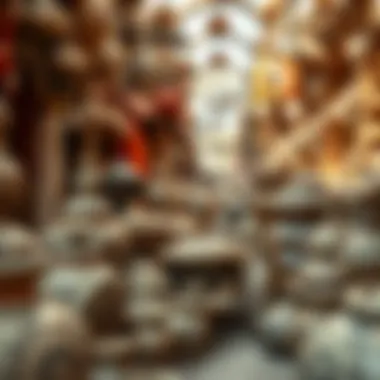
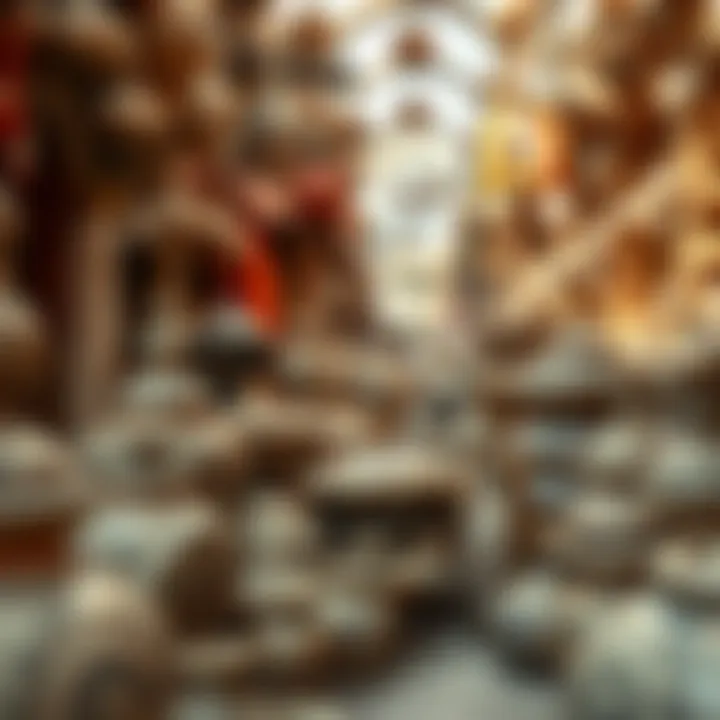
This market is significant not just for the sheer quantity of gold available, but also for the sense of community it fosters among traders and customers. The negotiation over prices can lead to some memorable interactions, fostering relationships that enhance both trust and understanding in the transaction process.
Moreover, the Gold Souk serves as a barometer of the current financial climate, affecting global gold prices based on local demand and trends. Shoppers and investors alike keep a keen eye on this dynamic sector, making it an essential stop for anyone looking to gauge market conditions.
Spice Souk
Entering the Spice Souk is akin to stepping into a mosaic of flavors and aromas. This marketplace is a haven for culinary enthusiasts and those interested in the historical role of spices in trade. Vendors line the streets with colorful sacks spilling over with saffron, cumin, and countless other spices, inviting visitors to savor the sights and scents.
The cultural significance of the Spice Souk goes beyond mere commerce. Spices have been a part of the UAE's trade routes for centuries, and this souk reflects that rich history. Engaging with shop owners often leads to stories about family traditions and the historical impact of spices on local cuisine, making the experience not just about shopping, but also about learning.
The ability to experiment with exotic ingredients can inspire both local and international dishes, fostering culinary creativity in restaurants and homes alike.
Textile Souk
The Textile Souk is a vibrant tapestry woven with culture and tradition, showcasing a variety of fabrics that reflect the diversity and richness of the region. From floating silks to colorful cottons, visitors marvel at the choices available. This souk is not just a place to purchase materials, but a center of cultural exchange where one can witness the intricate art of fabric selection firsthand.
Merchants are often seen engaging eagerly with customers, offering advice on the best fabrics for specific needs, be it traditional garments or modern attire. This interaction highlights the personal touch that characterizes shopping in the souks, making each visit memorable.
Additionally, the Textile Souk plays a unique role in the global fashion supply chain, influencing local designers who are keen to incorporate traditional fabrics into contemporary designs.
Together, these major souks exemplify the dynamic nature of UAE's marketplace culture, blending history with modern trends. They are not just destinations but experiences that enrich both locals and visitors, serving as essential pillars to the economy and cultural identity.
Unique Features of Souks
The souks of the UAE are not just marketplaces; they represent a unique intersection of culture, tradition, and commerce. Understanding the distinctive aspects of these vibrant spaces enriches the overall narrative of the region’s identity and its evolving economic landscape.
Architectural Elements
One of the standout characteristics of souks is their architectural beauty. Often, when wandering through these markets, one can’t help but appreciate the traditional design that harmonizes with the contemporary. Buildings typically feature narrow alleyways, archways and simple, yet striking, geometric patterns that evoke the history of Islamic architecture.
- Materials and Style: Many souks are built using local materials such as mud brick, coral, and palm fronds, which not only reflect the lifestyle of the past but also promote thermal comfort. It’s common to see intricate wooden doors and windows that provide a glimpse into the craftsmanship of local artisans.
- Layout: The layout is often designed to encourage flow. Shoppers drift from one stall to another, each showcasing an array of goods. This design fosters a sense of community, making it easy for locals and tourists alike to interact.
"Souks are not just shopping spots; they are hubs of culture, where every corner tells a story and every archway invites exploration."
Cultural Significance
Souks transcend mere commerce; they are a living representation of the Arab culture. They reflect the history and the value system of the Emirati people.
- Cultural Exchange: Throughout history, souks have served as melting pots of various cultures—traders from across the globe converging here to exchange goods and stories. This mix leads to a rich tapestry of heritage, evident in the wares sold, from spices to textiles.
- Community Engagement: The souks play an integral role in local life, not merely as trade centers but also as social hubs. Many traditional practices, such as storytelling and music festivals, transpire here, strengthening communal ties.
- Festivals and Events: This cultural importance also manifests during local festivals, where souks become focal points for celebrations, art exhibitions, and traditional performances, allowing people to connect with their roots.
Interaction Between Commerce and Community
The interplay between commerce and community in souks illustrates a dynamic relationship that is essential for the economic vitality of the UAE. Souks provide not only goods but also valuable social interactions.
- Local Economic Impact: The souks support local artisans and small businesses, enabling them to thrive in an increasingly competitive market. Shoppers often prefer buying directly from sellers, fostering a system that emphasizes community ownership.
- Visitor Experience: For tourists, souks offer an authentic experience far removed from the sterile environments of modern shopping malls. Engaging with local vendors, who often take pride in sharing their craft and culture, deepens visitors’ appreciation for Emirati heritage.
- Sustainability: The focus on local products and traditional crafts contributes to sustainability, ensuring that cultural practices and local industries are maintained for future generations.
Economic Impact of Souks
The souks of the UAE are not mere relics of the past; they play a pivotal role in the economic landscape of the region. The vibrant marketplaces offer a multitude of benefits, ranging from the preservation of cultural heritage to driving significant revenues for local businesses. Understanding the economic impact of souks is vital for investors, homebuyers, agents, analysts, and developers, as these bustling hubs embody both a rich history and a modern entrepreneurial spirit.

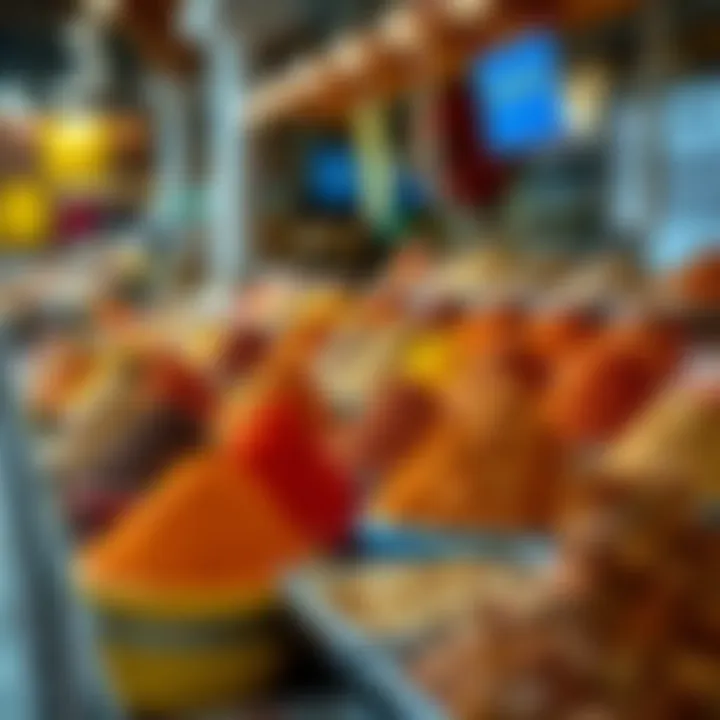
Contribution to Local Economies
Souks provide a thriving avenue for local merchants, artisans, and traders, contributing significantly to the economic fabric of their surrounding communities. Small businesses flourish here, often forming the backbone of local commerce.
- Employment Opportunities: The rise of local entrepreneurship within souks creates jobs, from stall owners to artisans, fostering a sense of community. This local employment helps reduce overall unemployment rates, providing a steady income to families.
- Revenue Generation: The sales generated from various products, such as spices, textiles, and traditional crafts, serve as a substantial source of income for not just the vendors but also the local tax base. This revenue can then be reinvested into public services and community development.
- Support for Artisans: Many souks prioritize homegrown talents. Local artisans often showcase their crafts, from intricate jewelry to handmade textiles, ensuring that traditional skills are passed down through generations. This not only enriches the community culturally but boosts the economy by preserving these trades.
The synergy of these elements highlights why understanding the economic impact of the souks is crucial. They are not just markets but integral players in the local economy.
Role in Tourism
Tourism is one of the cornerstones of the UAE's economy, and souks serve as a significant magnet for visitors seeking authentic experiences. These markets provide an insight into local culture, crafts, and cuisine that travelers are eager to explore.
- Attraction for Tourists: Souks such as the Gold Souk and Spice Souk draw millions of tourists each year, eager to engage with the local culture. Unique offerings attract not just sightseers but also shopper looking for one-of-a-kind souvenirs.
- Boosting Local Businesses: Increased foot traffic from tourists translates to higher sales for local vendors. This influx helps establish a cycle that promotes further investment in local commerce. Essentially, if the souks are bustling, the economic vitality of the area is likely thriving.
- Cultural Experiences: Tourists often value experiences that can’t be found in modern malls. Whether it’s the aroma of spices wafting through the air or the sight of traditional craftspeople at work, the souks offer a lens into the cultural identity of the UAE, effectively positioning them as central features in the touristic narrative.
"Souks are not merely a shopping destination; they are bridges across cultures, fueling the economy through engagement and experience."
Navigating the Souks
Navigating the souks is more than just walking through bustling marketplaces; it's an experience steeped in culture and tradition. For any visitor, familiarizing oneself with the nuances of these vibrant spaces can significantly enhance the overall experience. Souks are living representations of the historical and social fabric of the UAE, showcasing not only the products available but also the rich narratives behind them. Understanding how to navigate these markets is essential for anyone looking to make informed decisions, whether as a curious tourist or a potential investor.
Tips for Tourists
When stepping into the maze of a souk, it’s vital to come prepared. Here are some practical tips that can ease your journey:
- Dress Comfortably: Since souks can get quite crowded and the weather can vary significantly, opting for light, breathable clothing is always a good choice.
- Stay Hydrated: Carry a water bottle. Exploring can take longer than expected, and staying hydrated helps maintain energy levels for those endless browsing hours.
- Know Your Directions: Many souks can resemble a labyrinth. Familiarize yourself with landmarks or ask vendors for directions, especially if you’re on a tight schedule or looking for specific items.
- Carry Local Currency: While some places might accept credit cards, many vendors prefer cash. Keep some Dirhams handy to streamline purchases.
- Engage with Locals: More than just merchants, many local sellers offer captivating stories and insights about their goods, enhancing your understanding of the products on display. A friendly chat can open doors to unique items not typically advertised.
Understanding Bargaining Practices
Bargaining in a souk is an art and a vital part of the shopping experience. Here's how to navigate it effectively:
- Start Low: It’s customary to begin negotiations at a significantly lower price than what the seller asks. This not only allows room for negotiation but also sets the tone for the exchange.
- Be Respectful: Bargaining should always be done with a sense of humor and respect. Vendors appreciate friendly interaction, and being kind can sometimes yield better results.
- Know When to Walk Away: One of the most effective bargaining strategies is the willingness to walk away. If prices don’t meet your expectations, showing disinterest might prompt the seller to offer a better deal.
- Research the Prices: Before engaging, it’s helpful to have some baseline knowledge about the items you’re interested in. Researching online or checking with local guides can give you a fair idea of the going rates.
- Enjoy the Experience: Remember, the process of bargaining varies greatly depending on the product and the vendor's stance. Sometimes it’s about the conversation and connection, rather than just the final price.
In sum, navigating the souks is an intricate blend of cultural immersion and practical shopping savvy. With the right tools at your fingertips, your journey through these historic markets can be not only enjoyable but also fruitful.
Souks and Modern Retail
The landscape of retail in the UAE is a tapestry woven from threads of tradition, innovation, and cultural significance. The souks, cherished marketplaces steeped in history, are now facing the need to adapt to the shifting currents of modern retail. This section aims to illuminate the critical interplay between the enduring charm of souks and the rapid advancements in retail practices, focusing particularly on how these marketplaces can continue to thrive in a contemporary setting.
Blending Tradition with Modernity
The essence of the souks lies in their rich traditions. As spaces where generations have gathered to trade goods, socialize, and exchange stories, they represent more than mere marketplaces. Yet, the glyphs of time demand adaptation. A delicate balance must be struck between preserving the authenticity of these historic sites and integrating the conveniences offered by modern consumerism.
- Cultural preservation is paramount. Initiatives that maintain architectural integrity while enhancing visitor experience can draw crowds. For instance, introducing modern amenities like wi-fi access or digital signage can provide information without compromising the aesthetic.
- Interactive experiences have gained traction. Workshops for tourists on traditional crafts or cooking classes utilizing local ingredients can attract a younger audience, keen to learn about the culture firsthand without losing sight of their modern lifestyle.
- Additionally, combining traditional elements, like handcrafted goods, with modern retail practices, such as online pre-orders for items available in the souks, can bridge the gap between past and present. This synergy allows both tourists and locals to experience the market as it once was, while also enjoying the conveniences of digital shopping.
Impact of E-commerce
E-commerce has reshaped the retail landscape globally, and the UAE is not immune to its influences. While souks thrive on the tactile experience of shopping—where one can touch, smell, and barter—online shopping offers its own set of benefits. The challenge lies in reconciling these two formats without alienating the core identity of the souks.
- Increased accessibility is a significant advantage of e-commerce. Crafting an online platform where vendors can list their products broadens their customer base beyond just foot traffic. Imagine a spice seller from the historic Spice Souk now able to ship their products globally.
- However, e-commerce also fosters competition. Larger retailers can often flood the market with lower prices and broader selections. Local vendors need to enhance their value proposition by offering unique, quality products that stand apart and reflect their heritage.
- Furthermore, utilizing social media can create a robust online presence. Platforms like Instagram and Facebook can serve as visual showcases for the goods found in the souks, enticing buyers with stunning images and engaging storytelling.

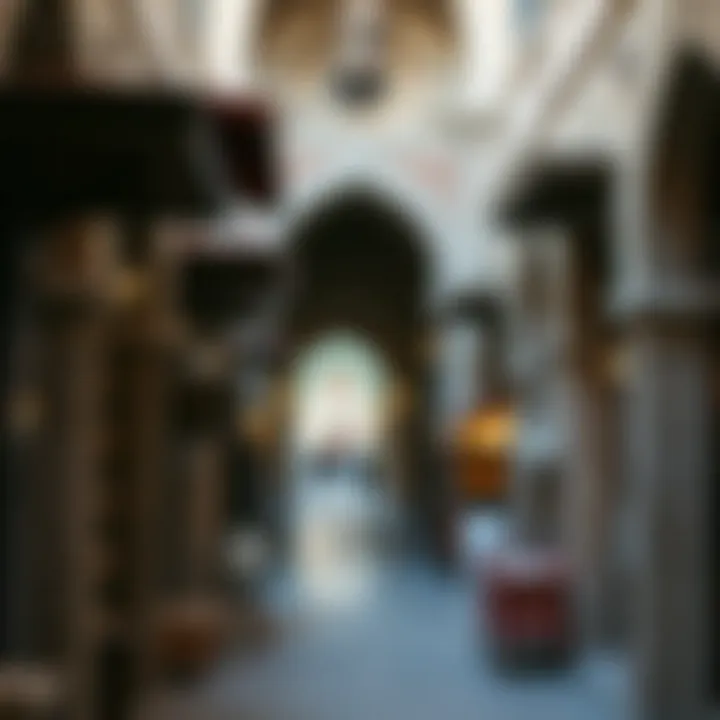
"Modern retail isn’t merely about technology; it’s about crafting experiences that resonate with a consumer's desire for authenticity and connection."
As we look toward the future, it is evident that the souks of the UAE must adopt strategic innovations while nurturing their traditional roots. This dual approach can not only ensure their survival but also amplify their role as cultural ambassadors in a rapidly evolving global marketplace. With tradition at their core and innovation guiding their path, the souks can continue to thrive amidst the waves of change in the retail world.
The Future of Souks
The souks of the UAE, with their vibrant atmosphere and rich history, find themselves at a critical juncture. As globalization steadily creeps into every corner of our lives, the souks must evolve to appeal to both traditional buyers and modern consumers. This doesn't mean abandoning their unique cultural essence; rather, it suggests a reimagining of their roles in today’s economy. The future of souks is pivotal not just for the markets themselves but for the larger social fabric they support. A thoughtful approach can create a synergy between preserving heritage and welcoming innovation, ensuring that these marketplaces continue to thrive in the coming years.
Preservation of Cultural Heritage
To understand the future of souks, one must first recognize the importance of preserving their cultural heritage. These marketplaces are not just places to buy and sell goods; they embody the very culture and history of the UAE. Each souk tells a story, from its architectural design to the traditional crafts sold within.
Visiting a souk is like stepping into a living museum. The art of negotiation, the scents wafting from spice stalls, and the colorful textiles all contribute to a sensory experience that connects visitors to the past.
Efforts for preservation can take various forms, such as:
- Cultural Events: Regular programs that celebrate traditional arts, crafts, and practices can keep the history alive in the minds of younger generations.
- Community Involvement: Encouraging local artisans to showcase their crafts helps maintain the authenticity of the goods sold.
- Government Support: Policies that promote the renovation of historic souks while maintaining their traditional charm can bolster interest and investment.
"The soul of our marketplaces is woven into the fabric of our communities; let’s not forget the threads that bind us to our past."
Adopting these strategies won’t just preserve the souks themselves; it will cement their status as cultural landmarks that can inspire future investments and tourism.
Innovation in Offerings
While preserving the past is important, innovation is equally crucial. As consumer preferences shift, souks have an opportunity to reimagine their offerings. In a landscape where convenience reigns supreme, introducing modern conveniences without losing the traditional essence can appeal to a broader audience. Here are a few areas where innovation can play a vital role:
- Digital Integration: Providing options for online shopping or virtual tours can make the souks accessible to those unable to experience them in person.
- Collaborative Spaces: Establishing areas where local artisans can work together or even host workshops can attract a younger crowd interested in the experience rather than just the product.
- Themed Market Days: Introducing focused days for specific products, like textile days or spice markets, can generate excitement and encourage repeated visits.
In balancing the old with the new, the souks can not only increase foot traffic but also enhance overall customer satisfaction. This strategy will be key in extending their relevance in an ever-changing commercial landscape.
Connection to the global marketplace doesn’t have to come at the expense of local culture. The future of souks in the UAE holds promise as long as they embrace their roots while also aiming for the stars.
The End
As we draw the curtains on our exploration of the souks of the UAE, it’s essential to reflect on their multifaceted significance. These vibrant marketplaces are not just hubs of commerce; they are vibrant cultural landmarks that weave together the past and present. Each souk evokes a sense of nostalgia while embodying the spirit of modernity. They showcase an impressive array of goods, from spices that tickle the senses to gold that catches the eye, drawing in both locals and tourists alike.
Recap of Significance
In essence, the souks serve as a living tapestry where tradition meets contemporary life. They function as:
- Cultural Heritage: Each souk preserves stories from different eras, providing insight into Emirati life.
- Economic Drivers: The influx of tourists and local business transactions underscores their role in boosting local economies, driving innovation in service delivery.
- Community Spaces: Beyond shopping, souks foster social interactions, contributing to the community's social fabric, where relationships blossom amidst vibrant stalls and aromas.
Overall, the souks symbolize the UAE's dedication to bridging cultural heritage with modern opportunities. They act as tangible points of convergence for businesses, communities, and visitors.
Final Thoughts
Looking forward, the future of the souks seems bright yet challenging. As e-commerce continues to grow, these traditional marketplaces must adapt while maintaining their essence. Opportunities abound in integrating modern facility offerings, enhancing customer experience, and preserving cultural narrations, which are vital for sustaining interest.
The charm of the souks lies in their ability to engage. They are invitation signs for different audiences—investors, tourists, and locals. By embracing innovation while cherishing tradition, the souks can remain relevant.
Ultimately, visiting the souks is not merely about shopping; it’s an immersive experience into the heart of UAE’s identity. As one meanders through the alleyways, there's a palpable connection to history, community, and commerce, serving as the perfect reminder of life's colorful complexities.
"Souks are the pulsating heart of the UAE, where every corner tells a story and every interaction adds to the dialogue between past and present."
For further insights, you can explore more about UAE's culture at Britannica or engage with the community on Reddit.
Keep an eye on these markets as they evolve, for they're not just places of transaction; they are a testament to resilience and adaptability.




